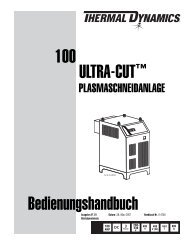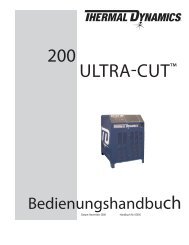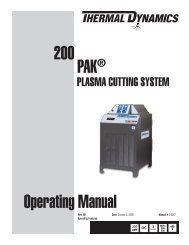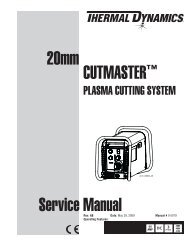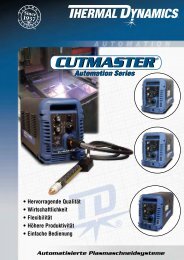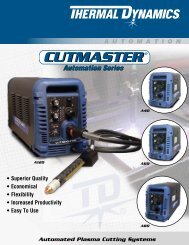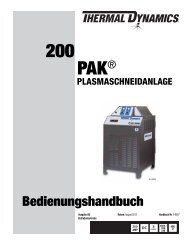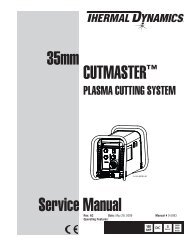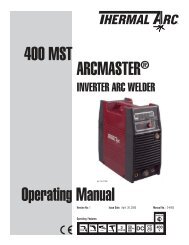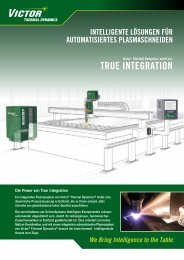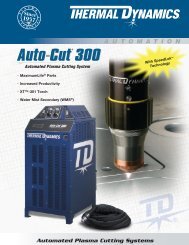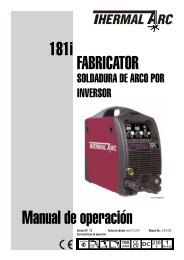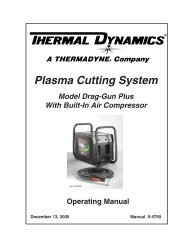211i Operating Manual FabricatOr® - Victor Technologies - Europe
211i Operating Manual FabricatOr® - Victor Technologies - Europe
211i Operating Manual FabricatOr® - Victor Technologies - Europe
Create successful ePaper yourself
Turn your PDF publications into a flip-book with our unique Google optimized e-Paper software.
INSTALLATION/SETUP FABRICATOR <strong>211i</strong><br />
B. Assessment of Area<br />
Before installing welding equipment, the user shall make<br />
an assessment of potential electromagnetic problems<br />
in the surrounding area. The following shall be taken<br />
into account.<br />
1. Other supply cables, control cables, signalling and<br />
telephone cables; above, below and adjacent to the<br />
welding equipment.<br />
2. Radio and television transmitters and receivers.<br />
3. Computer and other control equipment.<br />
4. Safety critical equipment, e.g. guarding of industrial<br />
equipment.<br />
5. The health of people around, e.g. the use of pacemakers<br />
and hearing aids.<br />
6. Equipment used for calibration and measurement.<br />
7. The time of day that welding or other activities are<br />
to be carried out.<br />
8. The immunity of other equipment in the environment:<br />
the user shall ensure that other equipment being<br />
used in the environment is compatible: this may<br />
require additional protection measures.<br />
The size of the surrounding area to be considered<br />
will depend on the structure of the building and other<br />
activities that are taking place. The surrounding area<br />
may extend beyond the boundaries of the premises.<br />
C. Methods of Reducing Electromagnetic Emissions<br />
1. Mains Supply<br />
Welding equipment should be connected to the<br />
mains supply according to the manufacturer’s<br />
recommendations. If interference occurs, it may<br />
be necessary to take additional precautions such<br />
as filtering of the mains supply. Consideration<br />
should be given to shielding the supply cable<br />
of permanently installed welding equipment in<br />
metallic conduit or equivalent. Shielding should be<br />
electrically continuous throughout its length. The<br />
shielding should be connected to the Welding Power<br />
Source so that good electrical contact is maintained<br />
between the conduit and the Welding Power Source<br />
enclosure.<br />
2. Maintenance of Welding Equipment<br />
The welding equipment should be routinely<br />
maintained according to the manufacturer’s<br />
recommendations. All access and service doors and<br />
covers should be closed and properly fastened when<br />
the welding equipment is in operation. The welding<br />
equipment should not be modified in any way except<br />
for those changes and adjustments covered in the<br />
manufacturer’s instructions.<br />
3. Welding Cables<br />
The welding cables should be kept as short as<br />
possible and should be positioned close together<br />
but never coiled and running at or close to the floor<br />
level.<br />
4. Equipotential Bonding<br />
Bonding of all metallic components in the welding<br />
installation and adjacent to it should be considered.<br />
However, metallic components bonded to the work<br />
piece will increase the risk that the operator could<br />
receive a shock by touching the metallic components<br />
and the electrode at the same time. The operator<br />
should be insulated from all such bonded metallic<br />
components.<br />
5. Earthing/grounding of the Work Piece<br />
Where the work piece is not bonded to earth for<br />
electrical safety, nor connected to earth because<br />
of its size and position, e.g. ship’s hull or building<br />
steelwork, a connection bonding the work piece to<br />
earth may reduce emissions in some, but not all<br />
instances. Care should be taken to prevent the earthing<br />
of the work piece increasing the risk of injury<br />
to users, or damage to other electrical equipment.<br />
Where necessary, the connection of the work piece<br />
to earth should be made by direct connection to<br />
the work piece, but in some countries where direct<br />
connection is not permitted, the bonding should be<br />
achieved by suitable capacitance, selected according<br />
to national regulations.<br />
6. Screening and Shielding<br />
Selective screening and shielding of other cables<br />
and equipment in the surrounding area may alleviate<br />
problems of interference. Screening the entire<br />
welding installation may be considered for special<br />
applications.<br />
<strong>Manual</strong> 0-5225 3-3 INSTALLATION/SETUP



